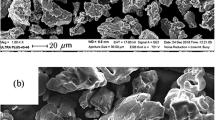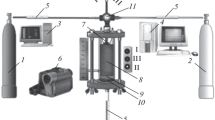Abstract
Dependence of the combustion of a Ti + C granular charge on a granule size is experimentally studied. It is revealed that the burning rate of a granular mixture of all fractions used in the work is higher than the burning rate of a bulk-density powder mixture. It is shown that, with a decrease in the granule size, the burning rate of the charge in the absence of gas decreases due to an increase in the number of boundaries between the granules per unit length of the sample. A strong influence of the nitrogen flow on the burning rate of both coarse and fine granules is established. It is shown that, in contrast to fine granules, an increase in the nitrogen flow rate of coarse granules up to 600 liters/h leads to a transition to convective combustion. The studies performed indicate that, despite the structural analogy between mechanically activated and granular mixtures, the relationship between the combustion time and the front transition time in granular mixtures is completely different. This means that the combustion of granular mixtures even in the absence of a gas flow cannot be explained within the framework of a microheterogeneous model.



Similar content being viewed by others
REFERENCES
M. A. Korchagin, T. F. Grigor’eva, B. B. Bokhonov, et al., “Solid?State Combustion in Mechanically Activated SHS Systems. I. Effect of Activation Time on Process Parameters and Combustion Product Composition," Fiz. Goreniya Vzryva 39 (1), 51–59 (2003) [Combust., Expl., Shock Waves 39 (1), 43–50 (2003)].
N. A. Kochetov and I. A. Studenikin, “Burning Velocity and Sample Length Change for the 5Ti + 3Si System. Effects of Mechanoactivation, Thermoevacuation Treatment, and Ambient Atmosphere Pressure," Khim. Fiz. 37 (1), 43–48 (2018); DOI: 10.7868/S0207401X18010089 [Russian J. Phys. Chem. B 12(1), 77–82 (2018)].
S. G. Vadchenko, “Effects of Obstacles on the Passage of Filtering Combustion Waves along a Porous Titanium Tape," Fiz. Goreniya Vzryva 55 (3), 43–49 (2019) [Combust., Expl., Shock Waves55 (3), 282–288 (2019); DOI: 10.1134/S0010508219030055].
B. S. Seplyarskii and R. A. Kochetkov, “A Study of the Characteristics of the Combustion of Ti + \(x\)C (\(x > 0.5\)) Powder and Granular Compositions in a Gas Coflow," Khim. Fiz.36 (9), 21–31 (2017); DOI: 10.7868/S0207401X17090126 [Russian J. Phys. Chem. B 11 (5), 798–807 (2018)].
B. S. Seplyarskii and R. A. Kochetkov, “Granulation as a Tool for Stabilization of SHS Reactions," Int. J. Self-Propag. High-Temp. Synth. 26 (2), 134–136 (2017); DOI: 10.3103/S106138621702011X.
B. S. Seplyarskii, R. A. Kochetkov, and T. G. Lisina “Convective Combustion of a Ti + 0.5C Granulated Mixture. Domain of Existence and Fundamental Phenomena," Fiz. Goreniya Vzryva 55 (3), 57–62 (2019) [Combust., Expl., Shock Waves 55 (3), 295–299 (2019); DOI: 10.1134/S0010508219030079].
B. S. Seplyarskii, R. A. Kochetkov, and T. G. Lisina, “Theoretical and Experimental Method for Calculating the Conditions of the Convective Mode of Combustion," Russ. J. Phys. Chem. B.13 (2), 267–272 (2019); DOI: 10.1134/S1990793119020064.
S. G. Vadchenko, “Gasless Combustion of a Model Multilayer System (Combustion of Disks with a Gap)," Fiz. Goreniya Vzryva37 (2), 42–50 (2001) [Combust., Expl., Shock Waves37 (2), 159–167 (2001)].
A. P. Aldushin and A. G. Merzhanov, Thermal Wave Propagation in Heterogeneous Media (Nauka, Novosibirsk, 1988) [in Russian].
B. S. Seplyarskii, A. G. Tarasov, and R. A. Kochetkov, “Experimental Investigation of Combustion of a Gasless Pelletized Mixture of Ti + 0.5C in Argon and Nitrogen Coflows," Fiz. Goreniya Vzryva 49 (5), 55–63 (2013) [Combust., Expl., Shock Waves 49 (5), 555–562 (2013); DOI: 10.1134/S0010508219030079].
S. G. Vadchenko, “Gasless Combustion of a Model Multilayer System (Combustion of Disks without Gaps)," Fiz. Goreniya Vzryva38 (1), 55–60 (2002) [Combust., Expl., Shock Waves38 (1), 49–53 (2002)].
A. A. Zenin, A. G. Merzhanov, and G. A. Niersisyan, “Thermal Wave Structure in SHS Processes (by the Example of Boride Synthesis)," Fiz. Goreniya Vzryva 17 (1), 79–90 (1981) [Combust., Expl., Shock Waves 38 (1), 63–71 (1981)].
A. S. Rogachev, A. S. Mukas’yan, and A. Varma, “Microstructure of Self-Propagating Waves of Exothermal Reactions in Heterogeneous Media," Dokl. Akad. Nauk 366 (6), 777–780 (1999).
A. S. Rogachev, N. A. Kochetov, V. V. Kurbatkina, et al., “Microstructural Aspects of Gasless Combustion of Mechanically Activated Mixtures. I. High-Speed Microvideorecording of the Ni–Al Composition," Fiz. Goreniya Vzryva 42 (4), 61–70 (2006) [Combust., Expl., Shock Waves 42 (4), 421–429 (2006)].
A. S. Rogachev, “Microheterogeneous Mechanism of Gasless Combustion," Fiz. Goreniya Vzryva 39 (2), 38–47 (2003) [Combust., Expl., Shock Waves 39 (2), 150–158 (2003)].
B. S. Seplyarskii, R. A. Kochetkov, T. G. Lisina, and N. I. Abzalov, “ Study of Mechanisms of Increase in the Combustion Rate of Diluted Granulated Ti + C Mixtures for Varied Amounts of Co-Current Gas Flow," Khim. Fiz. 39 (1), 1–8 (2020); DOI: 10.1134/S0207401X20010136 [Russian J. Phys. Chem. B 14(1), 52–58 (2020)].
Author information
Authors and Affiliations
Corresponding author
Rights and permissions
About this article
Cite this article
Seplyarskii, B.S., Kochetkov, R.A., Lisina, T.G. et al. Effect of a Ti + C Granule Size on Combustion in a Nitrogen Flow. Combust Explos Shock Waves 57, 60–66 (2021). https://doi.org/10.1134/S001050822101007X
Received:
Published:
Issue Date:
DOI: https://doi.org/10.1134/S001050822101007X




